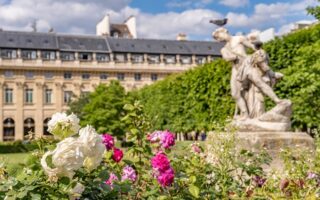Coming Up Roses: Masquelier’s Garden

“My garden is always en mouvement,” says Odile Masquelier of the magnificent rose garden at La Bonne Maison, her home on a hill overlooking Lyon and the Saône River. It takes only a first glance at her magical landscape to see what she means. Sumptuous swags of roses race up the side of the house, tumble around arbors, spill along walls, luxuriate languorously along a branch or loop like garlands through the trees with such joie de vivre that the sight invariably incites a smile of pleasure.
Or more movement. “When I saw a Swiss specialist running towards the house, I thought there must be an emergency,” Masquelier recounts. There was. “He had gone completely mad for one of my China roses and wanted a secateur to take a cutting right away.”
With over 800 varieties, Masquelier’s garden is considered the most exceptional private rose collection in France. Long a mecca for rose experts, the garden is still almost unknown to ordinary travelers in France, but even garden-variety garden lovers are beginning to catch on. Now much in demand as a lecturer, Masquelier herself spreads the word from Australia and South Africa to Uruguay and the United States where she has addressed such groups as the Southampton, Long Island Rose Society.
Designed around a series of terraces over a sloping terrain with a faraway view of Lyon’s skyline, the two-and-a-half-acre garden leads the visitor on a horticultural voyage of discovery, replete with surprises (there is even a secret garden), and not only of roses.
Masquelier’s lush scene embraces a host of other plants that play supporting roles or step center stage at other seasons. Blossoming cherry trees, a sweep of technicolor tulips and a swath of a thousand narcissus greet the eye in early spring, when the secret garden is a cornucopia of crocuses, more narcissus, reticulata iris, stylosa iris from Algeria and eight different varieties of snowdrops and hellebores.
Clematis is another active player, flinging itself up nearly 40 feet into lofty tree branches and flowering from April until November. A peony walk burgeoning with hedges of tree and Species (not hybrid) varieties, like the lemon-yellow tree peony Alice Harding (named for an amateur New Jersey gardener in the early 1900s) shares the April spotlight with early Persian and China roses, Masquelier’s newest passion. In May, resplendent white, yellow, pink and blue iris and delicate papery poppies are foils for the rose extravaganza, while clouds of white wisteria glow in the sunshine.
June features mixed borders where pale pink clematis and Max Graf roses—like crushed tissue paper—pop through drifts of Hidcote blue lavender and purple sage, campanula, blue Veronica spicata, tiny geraniums and day lilies that might be filled in with the lime green tobacco “because it goes with all the plums, pinks, mauves and blues.” There’s enough to look at for an entire afternoon.
Previously, the garden closed at the end of June, but recently Masquelier decided to reopen in September and October “to show off my rose hips,” she says, “the colorful fruit of the flowers,” along with the mixed borders, vibrant Japanese maples, tea roses, asters, colchicums and a collection of cyclamen she brought back from Cyprus and the Greek Peloponnesus. One highlight: a “collarette” of pink cyclamen around the base of an immense 1928 cedar whose branches stretch upwards in a “cathedral” spire.
But even with all the luxuriant competition, voluptuous roses are still the seductive superstars at La Bonne Maison, especially in late April, May and early June when “every day brings an explosion of something new,” says Masquelier, and her romantic style of plantings sets a scene of pure enchantment.
Democracy rules. Her roses live in mixed company on the arbors. “I hate symmetry,” she explains, “and now I have so many varieties that I don’t have much space.” A blend of white Neige d’Avril with a pale pink Euphrosyne, a deep purple Violette and a butter yellow Agalïa whose golden yellow buds open into ivory flowers gambol across a gloriette that she invented for her daughter’s wedding; on another arbor, a yellow, ivory and green tapestry of Easlea’s Golden Rambler, Claire Jacquier and Duchesse d’Auerstaedt shelters the birdbath in the Yucca Garden. A pink veil of Ethel roses shares a sturdy plum tree with Andre Eve’s hybrid rambler “Suzie,” whose huge, gorgeous yellow blossoms fade to pink and are such a sight that people ring up to see if Suzie is in bloom.
“But don’t think a rose will do what you want her to do,” Masquelier cautions. “She will do exactly what she wants. If you force her, she will die, look sick or be full of aphids. I have to guide them, of course. A garden isn’t a hospital. If a flower doesn’t do well in one place, move it or find something else that adapts better.”
These floral divas have personalities, she points out. Some are gentle, like the salmon pink Lady Waterlow who is a trooper in bad weather; others are sulky like the peachy tea rose Madame Jules Gravereaux, who balls up permanently in the rain. Some self-confident beauties—including the lovely pale pink centifolia Prolifera de Redouté—just take over. “She is invading everybody and I let her,” says Masquelier. “Maybe one day I’ll say that’s enough.”
And some roses are absolutely lethal. “I have two killers in my garden,” she reveals. Called the Sweetheart rose in the U.S., the pale pink climber Mademoiselle Cécile Brunner proved to be a femme fatale for Paul’s Himalayan Musk (he’s since been resurrected in a far-off cherry tree). When Meg, a striking coral pink rose suffused in peach, was moved next to similarly hued Cressida, she too made short work of her companion.
Despite its seemingly effortless elegance, the garden is the result of 42 years of determined labor, optimism and a steep learning curve for its creator, who started completely from scratch when in 1966 she moved back into what had been her childhood home and her Alsace-based family’s refuge during World War II. Inspired by visits with her young children to Lyon’s municipal gardens, her first plantings were full of lurid-toned annuals and modern roses.
A disastrous summer storm washed her early efforts to the bottom of the hill. “There was a lake in the courtyard,” she remembers, “but there is always something positive to learn from mistakes and catastrophes.” She and her husband Georges immediately decided to build walls (there are now 15) and terraces, plant hedges and seed lawns so it couldn’t happen again. In 1975, a visit to Scottish Highland gardens came as an eye-opener. “Perennials and wisteria grew through shrubs, old roses came in subtle colors—lavender, pale pink, gray and white—and the fragrance was amazing,” she recalls. “When I looked, I saw all their names were French!”
Back home, her Highland epiphany inspired a new beginning: Out with the garish, in with pale pastel heirloom roses and naturalistic planting. Six initial arbors grew to 16 as her choices became more sophisticated and her landscaping more poetic. The rank amateur metamorphosed into an eminent rosariste with a collection as beguiling as it is important.
Accompanied by birdsong, a visit through her stunning terrain reveals potently perfumed roses like the toffee-scented Noella Nabonnand, Madame Isaac Pereire and her own hybrid named for her granddaughter, Margaux, whose palest apricot-hued buds open to vanilla cream blooms with a spicy, fruity fragrance. There are rare roses such as Jacques Cartier, named for the French explorer of North America; Kléber, a soft pink moss rose named for Napoleonic general Jean-Baptiste Kléber; and the silvery pink Roi René for the Provençal king who had the first French rose garden. And there are extremely rare roses like Prince Albert (“most people think it’s extinct”) and her own “chance seedlings,” hybrids bred in her own garden like the successful Margaux that soars to a towering 49 feet; Bambou, a thorn-less rose with beautiful leaves and big hips; and Inès, named for her daughter-in-law, with superb pure white flowers and crimson leaves.
“I do nothing,” she contends. “The bees love Species roses and the birds eat the hips.” The reason it works is that “I stopped spraying with chemicals 20 years ago and gave up weed killer ten years ago because it bothered the birds and bees. And my roses are very healthy.”
Masquelier’s latest passion is her “impressive collection” of China roses. Global warming has had its effect at La Bonne Maison. “A China rose is resistant to drought and supports the cold better than one would think,” she says. “But you need patience. It grows very slowly and takes five years to become beautiful.”
Their provenances are almost as bewitching as their beauty. One of her favorites was dubbed the Pseudo Parks Yellow Tea Scented China when she discovered its characteristics are the opposite of the famous flower found by John Parks in China and brought back to England via the East India Company. “His was a small shrub, not a huge climber, with canary yellow blossoms that repeated. Mine is gigantic, with cream colored flowers and doesn’t repeat, but has an extraordinary perfume,” she explains. Another Chinese “splendor” that she expects to take off in popularity is the fragrant Lijang Road rose, a rambler discovered ten years ago on that Chinese road in Yunnan with “fantastic shocking pink huge double blooms that open 600 to 700 at a time.”
Masquelier acts almost as a rose missionary, taking for example such China roses as Fortune Double Yellow (apricot and chamois shaded flowers that have carmine centers) to Uruguay and South America. “When Robert Fortune spotted it in a mandarin’s garden in 1835, he wrote that he couldn’t believe his eyes,” she recounts.
Other favorites include R. laegvigata, known in the U.S. as Cherokee Rose, a fragile but, once established, invasive flower doing well under her care; R. hugonis, a honey-scented rose bush that grows to a 13-by-13-foot “fountain of gold”, and the difficult to find and harder to raise Primula, a yellow rose with incense-perfumed blooms and foliage that resembles a primrose and was discovered in Samarkand in 1910. Primula thrives so well here that the Lyon INRA (Agricultural Research Institute) has propagated from it, using a new in vitro process.
“Roses lead you to so many things,” she confirms. When the airline staff discovered they had a rose expert on board on a long-haul flight from South America, Masquelier was immediately upgraded to Club Class. “During the flight,” she says, “I gave advice to the whole crew about their roses.”
99 chemin de Fontanières, La Mulatière, 20 min from downtown Lyon on bus 29, 04.78.37.38.37. Open Mar 1-Jun 30 and Sept 1-Oct 31. Entrance fee: April, May and June: €9; March, Sept and Oct: €7. website
Originally published in the May 2008 issue of France Today; updated in May 2011.
Share to: Facebook Twitter LinkedIn Email
Leave a reply
Your email address will not be published. Required fields are marked *



